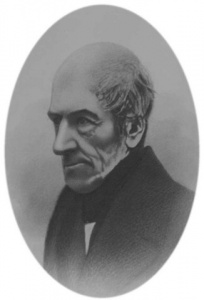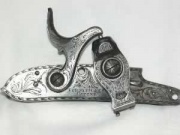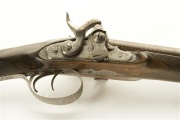Alexander John Forsyth
| Alexander John Forsyth | |
|---|---|

| |
| Born | December 28, 1768 Belhelvie, Aberdeenshire, Scotland |
| Died | June 11, 1843 (aged 74) Aberdeenshire, Scotland |
| Occupation | Inventor, clergyman |
| Known for | invented the percussion firing system |
Gunsmiths like Joseph Manton invented more reliable forms of ignition, like the tube lock in 1814. The artist Joshua Shaw designed what is recognized today as the percussion cap, which he patented in the United States in 1822, since Forsyth had threatened his rivals in Britain with legal action. These new forms of ignition proved popular among hunters during the Regency period (circa 1811-1820), who had their old reliable flintlocks converted.[2]
[edit] Life
Forsyth was educated at King's College, Aberdeen, and succeeded his father as minister of Belhelvie in 1791.[3]
While hunting wild duck, he was dissatisfied with his flintlock fowling-piece due to its hang-fire; by the time the pellets were discharged the duck had time to dive before the shot reached them.[2] Trying to overcome these problems, Forsythe began his research. Explosive compounds (such as mercury fulminate) were known before, but they were too powerful to simply replace the powder; some other way had to be found to use them in a firearm without blowing the gun (and probably a good portion of the operator as well) apart. His first design appeared in 1805 and he patented his scent-bottle lock April 11, 1807; this was a small container filled with fulminate of mercury used to initiate the powder charge[4]. However, such a microburst lacked focus and the flash could not manage to reliably ignite the charge in the barrel.
This problem was solved with a small cylinder filled with explosives, which was located at the base (breech) of the barrel. Because of the characteristic shape of the cylinder, the arrangement is often called a "bottle" lock (scent-bottle lock), although the Forsyth used the term "explosive" lock (detonating lock). To make a shot, you had to turn it to the shelf spilled seed - mercury fulminate or other mixtures of this kind, which ignited on impact hammer on a special hammer. The French gunsmith Jean Lepage developed a similar form of ignition later in 1807 based on Forsyth's design, but this was not pursued.
During the Napoleonic Wars, Forsyth presented his invention to Lord Moira, Master of Ordnance. He was impressed by the novelty and by Forsythe, who was invited to the Tower Armouries where he continued to tinker with his design under the auspices of the state. Unfortunately, Moira's replacement, Lord Chatham, canceled all decisions of his predecessor and Forsyth was dismissed; other experiments had had destructive results and the new master general was rather jittery at the notion of seeing Britain's main arsenal destroyed. Forsythe found himself independent and in June 1808 in London, founded the Forsyth & Co. Patent Gun Manufacturers and began to produce weapons with the locks of his design . One of his workers, James Purdey, would later became a famous designer of weapons himself.Forsyth's design presented several difficulties with being produced and used en masse, particularly in the army, due to its many small parts which could be shattered by gunshots and otherwise easily broken. More research was needed, for which Forsythe was not in a position to finance: his business was not going too well, as evidenced by the fact that in 1816 he moved from the premises on Piccadilly Street on a more modest setup outside Leicester. Nevertheless, his ideas showed great potential, as evidenced by the fact that Napoleon Bonaparte offered Forsyth a reward of £20,000 (about £300,000 in today's money) if he took his invention to France. Forsyth, still a patriot and not willing to trust a Frenchman as far as he could be tossed, declined.
Forsyth's design eventually found application in the British army, though in a somewhat modified form. In 1839, the British Army adopted the first gun with primer locks, replacing the iconic "Brown Bess" British Land Pattern Musket. Instead of a complex "bottle" the new muskets used a copper cap filled with explosives. The appearance was different, but the principle the same: a shock mechanism initiating a small charge of explosive. The government even planned to make the appropriate payment to Forsyth as the holder of the patent, but for a gaggle of legal procedures and a lack of time, due to Forsyth's death in 1843.
Part of this historical oversight was rectified in 1930, when two plaques were dedicated to Forsythe - one in King's College, Aberdeen, and the second in the Tower of London.
[edit] References
- ↑ Overview of Rev. Alexander John Forsyth, The Gazetteer for Scotland (2008)
- ↑ 2.0 2.1 Ricketts, H., Firearms (London, 1962)
- ↑ Myatt, F, 19th Century Firearms (London, 1989) p.18
- ↑ Alexander Forsyth in Encyclopædia Britannica
[edit] External links
- "Forsyth, Alexander John". Dictionary of National Biography. London: Smith, Elder & Co. 1885–1900.

